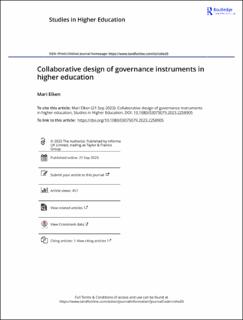| dc.description.abstract | There is considerable focus on finding effective governance approaches. This article examines experiences with using more collaborative approaches to developing new governance instruments in the context of higher education. The specific empirical case focuses on the introduction of multi-annual performance agreements between the ministry and the higher education institutions in Norway. Specific focus is on the pilot process, during which the instrument was developed in collaboration between the ministry and representatives from the higher education institutions. The article takes a starting point in a contingency model for collaborative governance, and examines starting conditions, institutional design and leadership models, and the characteristics of the collaborative process itself, including the role of face-to-face dialogue with good faith negotiation, a trust-building phase, a commitment process, followed by a shared understanding of the problems, values and goals, and intermediate outcomes. The data consist of approximately 50 qualitative interviews with representatives from the ministry and the higher education institutions and a range of document data. The paper analyses how the collaborative design process in Norway shaped policy outputs, and highlights critical factors of the process, including the consequences of the temporal sequencing of the process, the interaction of the new governance instrument with the existing instrument mix, and the role of various other concurrent policy developments. The analysis also points out that while collaborative approaches can provide ways to strengthen legitimacy of governing, they also involve a number of dilemmas and challenges, and therefore require careful design. | |
